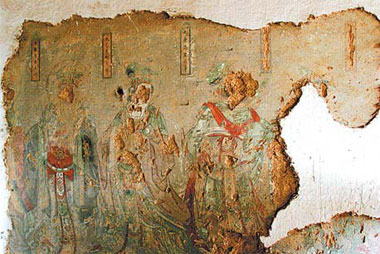The 6-sq-m colored paintings show the main figures of Taoism, but unfortunately the artworks were defaced.
"The former residents were afraid of being cursed, living in a temple which was supposed to be made for immortals," Liu Zhenying, a member of the Zhangjiakou Historical and Cultural Research Organization, explains. "They scratched the eyes and faces on the frescoes so the immortals were not able see them."
Some of the paintings' inlaid gold is also gone.
In spite of such severe damage, visitors can still see how graceful the paintings must have been.
"The only thing we can do to protect the temple is to lock it up, as we don't have enough money right now," Liu sighs.
 |
| Traces of the city's past glory are still visible, such as the 400-year-old frescoes in a Taoist temple. |
As I walked through the ancient town, I stopped to admire the view of some old dwellings, featuring delicate brick carvings and elegant screen walls.
Traces of the city's past glory are still visible, such as the 400-year-old frescoes in a Taoist temple.
Iron-framed windows and doors, which are common in big cities to protect against burglars, can hardly be seen here. On the contrary, most dwellings are open to visitors.
The smoke of a coal stove on the roadside and many faded red slogans painted on the walls made me feel like I had ventured back into the 1960s.
"The local economy is behind other big cities and because of it the town is largely preserved," Liu says.
Buzili shifted from being a military town to a commercial county in the 1700s. Thousands of traders flocked from all over the country to conduct business.
"Only the richest businessmen could afford to build luxury houses inside the town at that time, while the others had to live outside. This is why Buzili is dotted with various old buildings of different styles, including Beijing traditional quadrangle dwellings, Shanxi-style ones and Anhui-style houses," Liu says.
Nowadays, these historical buildings are either occupied by locals, or used for social services.
Wenchangge, also called the Bell Tower by locals, is located in the town center.
It was amazing to see its Roman-style dome above the crossroads. "It shows that Zhangjiakou was influenced by Western culture long ago," Liu says.
Operating during the Ming and Qing dynasties (1368-1911), the Zhangjiakou-Kunlun ancient commercial route brought a great number of foreign traders to China.
The 4,000 km journey started from Dajingmen, through Kunlun in Mongolia, and ended in Charktu, Russia.
It reached its peak at the end of the Qing Dynasty (1644-1911), with an annual turnover of 150 million taels of silver, equal to 17 billion yuan ($2.3 billion). Due to the city's significant role in trading, the Zhangjiakou-Beijing railway was built in 1909.
The flourishing economy attracted 44 foreign banks from Germany, the United States, Japan and Britain, all of which established their own branches here. About eight of these buildings are still extant.